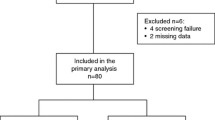Abstract
Purpose: The Breast Cancer Site Group of the National Cancer Institute of Canada – Clinical Trials Group (NCIC-CTG) undertook two parallel phase I studies to determine the maximum tolerated dose (MTD) and recommended phase II dose of vinorelbine in combination with doxorubicin and fluorouracil (with or without folinic acid) in metastatic breast cancer. Methods: Cohorts of five patients were to receive: (a) fluorouracil 500 mg/m2 and doxorubicin 50 mg/m2 on day 1 only and escalating doses of vinorelbine (15, 20, 25, 30 mg/m2) on days 1, 8 and 15 every 3 weeks (FAN regimen), or (b) fluorouracil 340 mg/m2 and folinic acid 200 mg/m2 on days 1, 2, 3, 4 and 5, doxorubicin 40 mg/m2 on day 1 only and escalating doses of vinorelbine (15, 20, 25, 30 mg/m2) on day 1 and again on day 5 every 4 weeks (SUPERFAN regimen). Eligibility included measurable or evaluable metastatic breast cancer and having received neither previous chemotherapy for metastatic disease nor anthracycline-containing adjuvant therapy. Results: Of 26 and 12 patients enrolled in the FAN and SUPERFAN regimens, 26 and 12 were evaluable for toxicity and 21 and 9 for response, respectively. Median ages were 60.3 years (41–71 years) and 64.2 years (51–73 years). Both regimens required amendment after the first cohort with an original day-15 vinorelbine dose omitted from the FAN regimen and more prolonged nadir granulocyte counts allowed. Myelosuppression was dose limiting. MTDs in the FAN and SUPERFAN regimens were vinorelbine 25 mg/m2 and 20 mg/m2. Other toxicities included mucositis, septicemia and febrile neutropenia. Peripheral neuropathy and constipation were mild. Of the 21 FAN patients evaluable for response, 3 (14%) had complete responses and 7 (33%) had partial responses, for an overall response rate of 48%; 9 (43%) had stable disease and 2 (9%) had progressive disease as their best response. Of the nine SUPERFAN patients evaluable for response, none had a complete response. There were two (22%) with partial responses, and six (67%) had stable disease and one (11%) had progressive disease as their best response. Conclusions: The SUPERFAN regimen was too toxic to pursue even at the lowest dose. The recommended phase II starting dose for the FAN regimen was vinorelbine 20 mg/m2. Although these were phase I studies response rates in evaluable patients were less than expected and toxicity did not allow the use of as much vinorelbine in the combinations as had been anticipated. The limited response data from our study would imply that combining vinorelbine with more toxic agents may not enhance response rates and may defeat the advantage of tolerability, especially in elderly patients.
Similar content being viewed by others
Author information
Authors and Affiliations
Additional information
Received: 7 December 1996 / Accepted: 8 May 1997
Rights and permissions
About this article
Cite this article
Goss, P., Fine, S., Gelmon, K. et al. Phase I studies of fluorouracil, doxorubicin and vinorelbine without (FAN) and with (SUPERFAN) folinic acid in patients with advanced breast cancer. Cancer Chemother Pharmacol 41, 53–60 (1997). https://doi.org/10.1007/s002800050707
Issue Date:
DOI: https://doi.org/10.1007/s002800050707




